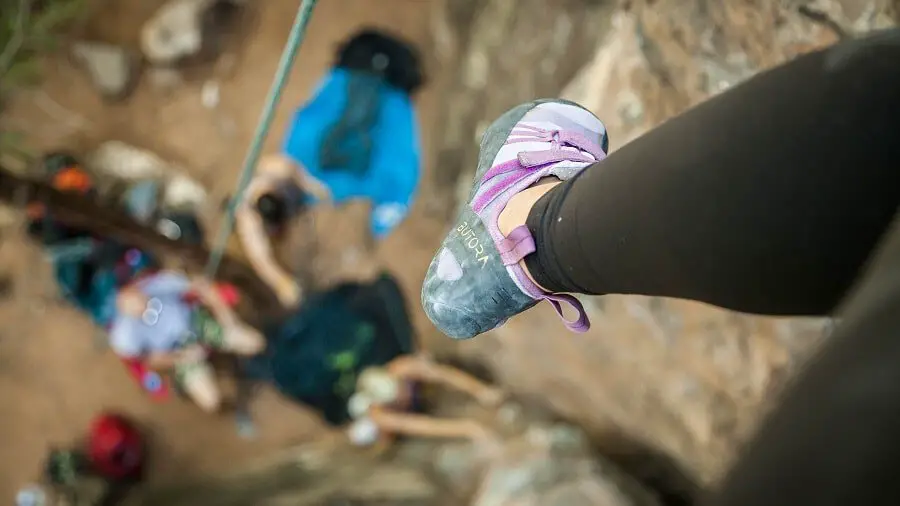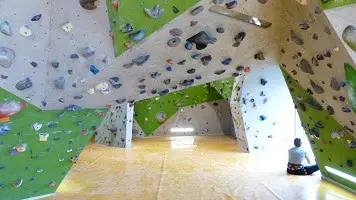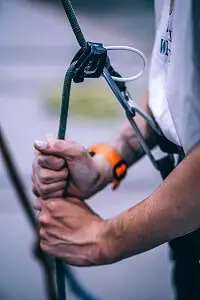Disclosure: Links marked with * are Affiliate Links. As an Amazon Associate, I earn from qualifying purchases if you decide to make a purchase through these links – at no cost for you!
 Rock climbing is about reaching the top. But sometimes thoughts only revolve around the opposite, the worst case: the fall into the abyss. A large part of your climbing equipment is designed to make the (unavoidable) fall as safe as possible. Falling while rock climbing is completely normal. But what if you’re afraid of heights and still want to climb? Despite all reason, sometimes primitive fears triumph in our subconscious. How can you overcome the fear of heights when rock climbing? As with many other fears, you have to expose yourself to them in small bites to get used to them and then overcome them. These bites are controlled situations in which we control the risk. In a climbing hall or while bouldering you can best work on your fear of heights. If you feel safe there, you can go on outside!
Rock climbing is about reaching the top. But sometimes thoughts only revolve around the opposite, the worst case: the fall into the abyss. A large part of your climbing equipment is designed to make the (unavoidable) fall as safe as possible. Falling while rock climbing is completely normal. But what if you’re afraid of heights and still want to climb? Despite all reason, sometimes primitive fears triumph in our subconscious. How can you overcome the fear of heights when rock climbing? As with many other fears, you have to expose yourself to them in small bites to get used to them and then overcome them. These bites are controlled situations in which we control the risk. In a climbing hall or while bouldering you can best work on your fear of heights. If you feel safe there, you can go on outside!
When fear sets in, fight the panic, take a deep breath and fight your fear of heights with reason and trust in yourself, your safety partner and your equipment.
How does your body react to fear?
Everyone reacts differently to high altitudes. There are those who stand on a vertical cliff without flinching and are thrilled by the view. And there are those who cling to the ladder while cleaning and breathe a sigh of relief when they are back on solid ground.
The fear of heights is not only unpleasant, it also interferes with climbing. The fear of a threat manifests itself in the instinctive decision between fighting, fleeing or freezing. Fighting and fleeing are not really directly transferable to rock climbing, because you can neither knock out the gravity nor flee from it.
The most common reaction when climbing is complete freezing – sometimes even so intense that it hurts. I’ve seen this strong reaction twice before. Both situations were in the controllable environment of a indoor climbing hall and we were able to calm them down. The best thing, however, was that both of them wanted to climb again immediately after this panic attack and this time more self-confident and with less fear of heights.
However, complete freezing is only the extreme. Usually the fear is not visible from the outside.
But even without the fear manifesting itself physically, it can considerably reduce our fun in climbing and our performance.
Many climbers cannot reach their full potential because their unconscious fear prevents them from doing so. Even if you have very little fear, you hold on too tight and lose too much strength unnecessarily. Moreover, creative movements and thoughts are limited when part of our consciousness is concerned with the threat of falling.
Bouldering against Fear of Heights
 If you want to face your fears, you can either do it very fast with a high dose, or slowly in small steps. Everybody’s different here. I have noticed that bouldering is the ideal approach for people who want to climb despite their fear of heights.
If you want to face your fears, you can either do it very fast with a high dose, or slowly in small steps. Everybody’s different here. I have noticed that bouldering is the ideal approach for people who want to climb despite their fear of heights.
When bouldering you don’t use a rope, because the height you climb to is not very high. The whole floor is covered with thick sports mats. A fall while bouldering bears hardly any risks and you don’t get scared when you look down. Of course, for some people even a height of two meters above the mat is already too much. The nice thing about bouldering is that you can also simply climb parallel to the ground. Nobody is forced to climb the given routes. This way you can climb without fear.
In order to train your tolerance level, you can always climb a little further up. If your fear of heights doesn’t come up at all when bouldering, it’s time to climb the climbing wall!
The same applies to the climbing wall as well. Climb as far as your fear allows. A little further every time. The more you provoke your fear of heights, the better the training effect will be.
Don’t look down!
One of the first tips you get as a beginner is “don’t look down”. It sounds trivial, but it actually helps. Besides the fact that distances from above always look longer than they really are, we don’t even give our subconscious the chance to react to a potential danger.
If you concentrate on climbing, there is no place in your mind to think how bad a fall from this height would be.
However, it is not possible not to look down at all. You have to know where to put your feet. But if you just look down the wall until you reach your feet, you don’t have to look down to the floor. Control your eyes consciously. And if you do get scared, remember that the rope won’t break and your partner will secure you.
Familiarize yourself with your Safety Equipment
 Many people can suffocate their fears with reason. If you fully understand your equipment, know the knots by heart and know how much your carabiners can support, you can convince yourself that it cannot actually happen that you fall. Each piece of equipment is designed to withstand many times the load of a fall and many unlikely coincidences have to come together for an accident to occur.
Many people can suffocate their fears with reason. If you fully understand your equipment, know the knots by heart and know how much your carabiners can support, you can convince yourself that it cannot actually happen that you fall. Each piece of equipment is designed to withstand many times the load of a fall and many unlikely coincidences have to come together for an accident to occur.
Especially when you are outdoors, good quality is essential. Good, robust equipment is safe and durable.
Most of the climbing equipment is personal safety equipment (climbing helmet*, climbing rope*, carabiner*, belay device*, etc.) and is therefore subject to strict requirements, usually standards. The equipment must pass many tests before it can be sold. Checking your equipment regularly and knowing exactly how it works builds trust.
Check out the most important rules for your climbing safety in this article.
Practicing short falls with the Clip Drop Method
 I’ve never been afraid of heights myself. I don’t mind standing unsecured on a cliff or leading. However, at some point I realized that bouldering is less stressful than rock climbing with ropes at higher altitudes. So I became more aware of my fear of heights and came to the conclusion that despite my confidence in myself and my equipment I was afraid of uncontrolled falls.
I’ve never been afraid of heights myself. I don’t mind standing unsecured on a cliff or leading. However, at some point I realized that bouldering is less stressful than rock climbing with ropes at higher altitudes. So I became more aware of my fear of heights and came to the conclusion that despite my confidence in myself and my equipment I was afraid of uncontrolled falls.
The solution was the clip-drop method, which gradually took away my fear of falling. With this method you climb up a wall and every time you clip your rope into the next anchor, you drop! The safety partner should of course be informed so that he can prepare himself and is not scared all the time.
Initially, every fall will trigger an adrenaline rush. But if you are persistent and learn to deal with such falls better and better, you become more and more self-confident and a fall gets normal and can even be fun.
However, the falls should never be longer than two metres, as this would put too much strain on the rope and make it necessary to replace it. You should only use the clip-drop method in a climbing hall, otherwise you will unnecessarily stress the anchors placed in the rock. In a climbing hall, it is also a good idea to inform the staff running around so that they are not constantly alarmed.
What may Help in Extreme Situations
However, if for some reason your fear of heights gets out of hand and paralyzes you, a technique recommended by therapists can help with your fear of heights. Especially when you are already overwhelmed by fear and your body begins to disobey you, this can give you back your control.
Talk to yourself in a calm tone. It sounds weird, but when you talk to yourself, the raging thoughts of fear are suppressed and you can calm yourself down. It helps to replace fear with reason and trust.
Conclusion
The fear of heights can spoil the fun of climbing if you don’t fight it. Your body instinctively reacts to the threat of the fall and can paralyze you, negatively affect your performance and technique. Even if you don’t notice it, it can make you cling too strong and lose too much strength unnecessarily.
Getting used to your fear of heights and overcoming it is a big challenge. Bouldering is the best way to fight the fear of heights at the beginning. Fear of falling can be cured by falling. You must leave your comfort zone and trigger the stress situation of a fall. The more often you do this, the more you get used to the chance of falling while rock climbing.
Attention: You have to take care of your safety when climbing! The information on climbtheearth.com only helps you to learn. Before you climb, you should make sure that you have been properly instructed by an expert and that you follow all safety precautions.
Disclosure: This website is the property of Martin Lütkemeyer and is operated by Martin Lütkemeyer. Martin Lütkemeyer is a member of the Amazon Services LLC Affiliate Program, an affiliate advertising program designed to enable Web sites to earn advertising revenue through advertising and linking to Amazon.com. Links marked with * are affiliate links.
